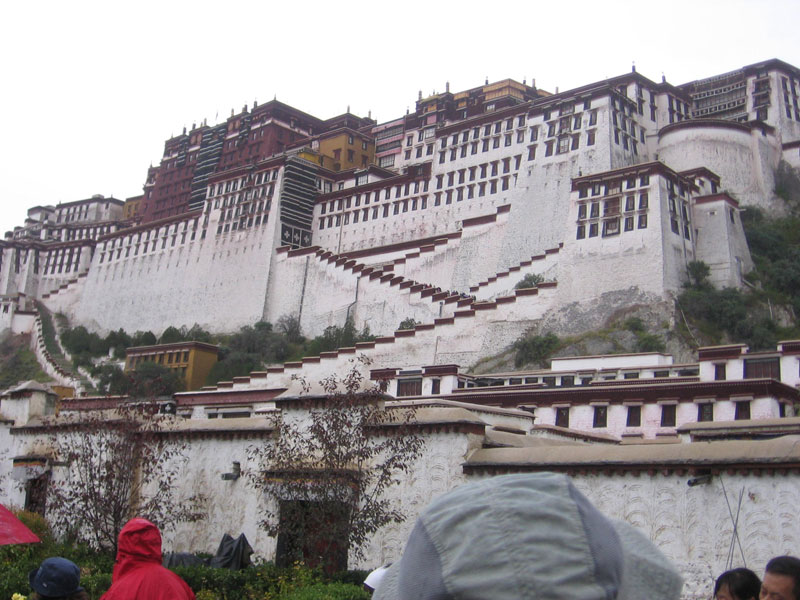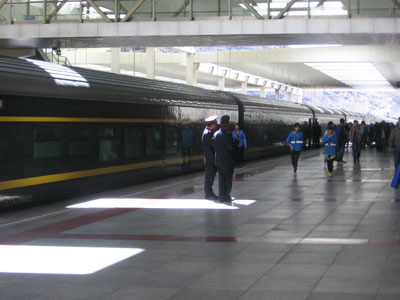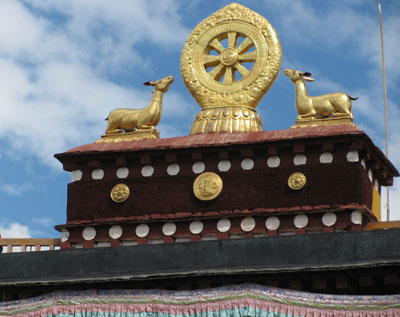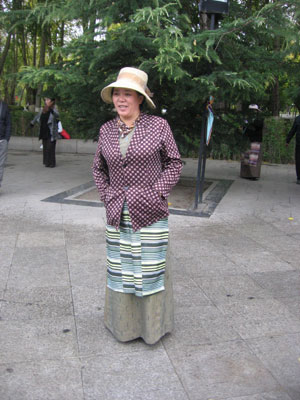Traveling by train from Beijing to Lhasa
This article appears on page 44 of the March 2014 issue.
by Gloria Helmuth; Tulsa, OK
One of the great joys of travel is the experience of getting to a new destination. My husband, Ed, and I long ago decided to try different means of transportation, when possible, to reach our destinations. So when I read about a train that takes passengers from Beijing to Lhasa, Tibet, it seemed like an ideal travel experience to try. We had no idea what to expect.
The route
On Sept. 28, 2013, we arrived in Beijing early in the morning after a long, multileg flight from our home base in Tulsa. We spent that day and night in our hotel and began taking the high-altitude medication prescribed by our primary care physician. Acetazolamide (aka Diamox) was the recommended medication.
We chose to fly into Beijing and take the train to Lhasa, rather than do the reverse route, in order to help acclimate ourselves to the altitude during the journey. In theory it sounded good, but, as it turned out, the train crew added oxygen to the air-conditioning system to keep passengers comfortable, so, upon our arrival, the higher altitude was still a concern.
Said to be the highest railway ever constructed, this line uses high-tech transport systems to cross the fertile plains of the Yangtze, Yellow and Lantsang rivers, traveling over Qarham Lake, Asia’s largest salt lake, and past the Kunlun Mountains. The route traverses 4,064 kilometers (2,525 miles) and goes from 143 feet in elevation at Beijing to 11,975 feet at Lhasa via Tanggula Pass (17,162 feet).
Life on board
The continuous-rail track, laid in 2006, provided an easy, smooth ride. The train has only six scheduled stops between Beijing and Lhasa; however, signals may be put out at any of the other 39 stations en route for passenger pickups. The trip takes 48 hours.
The train leaves in the evening from Beijingxi, the train station in the western part of the city, rather than from the main station in the heart of Beijing. The station is often crowded, especially on weekends and holidays, and we had chosen the beginning of the Chinese National Day Golden Week (beginning on or around Oct. 1) for our trip, which meant extra-heavy crowds.
Accommodations on board included regular seats, mostly for locals going only part of the way to Lhasa, hard-berth cabins, each with six bunk beds, no bedding and little headroom, and soft-berth cabins, which each have four beds with linens, two beds up and two down. We were fortunate to get a soft-berth cabin, arranged by our tour company.
We did not know until after we boarded the train that there was no club car and that the dining room car was closed except during meals. Therefore, we had to sit on our beds (which were not made down into seats during the trip) for most of the ride. The conductor even shooed us back into our cabin when we attempted to walk the train for exercise.
We found it confining to be cooped up in our cabin with strangers for over 45 hours, but the upshot of such confinement was that we got to know our cabinmates very well.
Fortunately, we were assigned a cabin with a young couple from the Netherlands and they both spoke excellent English. As our cabin was the size of most dining room tables, we had to rearrange legs when one of us wanted to leave the cabin.
The train carried about 850 passengers on our trip. We saw only eight other Westerners: our cabinmates, one couple from Australia, a couple from Switzerland and one other couple from the States.
A few details
The toilets were located at one end of our train car. One toilet was Western style and the other was Eastern style, only a hole in the floor. No toilet paper was provided, minimal cleaning (if any) was done, and a sink outside the toilets had running water but no soap or hand towels. I always travel with a roll of toilet paper, and we had wipes to use for our sanitary needs.
No shower facilities were available on the train. The water pressure we observed when washing our hands was so low that a shower would not have been possible even if offered.
The linens provided were not of great quality. The duvet was narrow and short, and we had a buckwheat pillow and a foam pillow.
I had taken along (and used) my silk sleep sack. It paid for itself during those two nights on the train.
Food could be purchased in the dining car. The menu had about 40 items on it, but only eight items were available during this trip. The food was too greasy for our tastes, so we ate the snack items we had taken along. We had trail mix, dried fruits, nuts and granola bars to nourish us.
Bottled water was sold on the train, but we were unable to find any nonflavored water. We did purchase some sticky rice to have some hot food (two yuan per serving).
To manage the dining experience, I’d suggest going to the far end of the dining car, where the attendant has the only menu. It has English translations alongside the items listed in Mandarin. Point to what you want and pay the attendant. He will give you a slip of paper to hand to the attendant at the opposite end of the dining car, who will dish up whatever you’ve paid for. You may eat in the dining room (tables must be shared) or take your food back to your cabin.
The conductor knew only a little English. His words to us were, “Be careful,” “Put valuables away” and “No.” Because of his warnings, and for general safety, we adopted the rule of leaving at least one person in our cabin at all times. (The cabins could not be locked from the outside.)
We kept the cabin locked from the inside when we were there, and at night I slept with our travel documents under my body. Twice I heard someone trying to get into our cabin at night. Hopefully, it was only a case of mistaken location.
A matron came by a couple of times each day to take away trash from our cabin, but no other upkeep was done while we were on the train. We had to put our suitcases into the space over the hallway, as they would not fit under the seating area in our cabin.
Each bed had a reading light, but it was not bright enough to read by. The one overhead light was better, but it needed to be turned off for sleeping.
Each bed also had a receptacle for oxygen hoses to be connected; however, no oxygen was available for purchase, even though we’d been told it would be. Instead, oxygen was pumped into the cabins via the heating or cooling system as we began to reach the higher altitudes.
There was no ladder to make getting into the upper berth easier. My husband is nearly 80, and he found it difficult. We finally developed a technique whereby our young male cabinmate would boost Ed up and into place.
The video monitors in our cabin did not work, and, as we walked through our car (we were not allowed to wander through the entire train), we did not see any monitors that were working.
Recommendations
In order to have more privacy and more space, I’d recommend booking an entire cabin for one person or one couple. The rate for a soft berth was $158 for one person ($316 for the two of us) from Beijing to Lhasa. A couple could be much more comfortable by paying $632 for an entire cabin so they could have two lower-level beds. However, because the soft-berth cabins are in short supply and we were going during the Chinese national holiday week, we were not allowed to book the extra space.
A special Tibetan travel permit is required for this trip. If you do not have a travel agent making your arrangements, be sure you arrange to pick up this permit in Beijing. Allow 10 days’ processing time. Tibettravel.org is one of the Asian agencies specializing in tours to Tibet, especially for those using the train.
You will also need a copy of your passport (valid for at least six months after the end of your tour there), a copy of your China tourist visa and an itinerary indicating where you will be visiting and staying.
Our tour was arranged through General Tours of Keene, New Hampshire (800/221-2216). They arranged for the train and our 2-day tour in Tibet. Though they normally don’t arrange tours for only two days, this was part of a longer tour we booked with them to Asia. They do offer a 4-day tour of Lhasa for $1,299 per person.
Touring Tibet
Once we arrived in Lhasa, we were met by a guide and taken to the Sheraton Lhasa. A late buffet dinner was included in our tour package, and we were ready for some good Western food.
Our room was comfortable, and most parts of the stay were pleasant. We were disappointed that the Internet was not working while we were there, as we’d been offline for the previous two days. We were able to use the hotel’s business center when it was not full of other guests.
The next morning we headed out for a long day of sightseeing in the city. The highlight of the day was our first stop, the Potala Palace. Hundreds, if not thousands, of people snaked their way through the entry and up the 1,036 steps into the 13-story series of buildings (1,000 rooms). Begun in the seventh century, this was the home of the Dalai Lama when he resided in Tibet.
Next we were off to Jokhang Temple near Barkhor Square, one of the main squares of the city. This seventh-century building is now the religious headquarters of the city.
Lunch was at Lhasa Kitchen, one of the main restaurants in central Lhasa that caters to Westerners. English was the main language in the room, but we did find some Eastern dishes to enjoy.
Then we toured the Lhasa Tsamkhung Nunnery, the first Buddhist nunnery we’d ever visited and a replacement for our scheduled visit to Sera Monastery, which was closed the day we arrived.
A stop in the main part of the town to see what the locals were selling from their kiosks completed our day.
The following day we toured some of the countryside, enjoying the nice views before arriving at Lhasa’s Gonggar Airport, located about an hour’s drive outside of Lhasa.
Summing up
While we had seen it referred to as the “new train” from Beijing to Lhasa when researching this trip, only after we were on board did we learn that, in fact, only the track is what is new. Our railcars were very old, and they had not been well maintained.
Would we do the trip again? Probably not, but we are not sorry that we did it once.
It was physically difficult for us, but we saw such beautiful scenery: lakes, mountains, valleys, small towns, cities, mining operations and agricultural areas. Yaks wandered alongside the train tracks, and we watched farmers using them to plow their fields. Once we were inside the Tibetan territory, we also frequently saw military posts on each side of the train track.
It was a great experience, providing us with warm memories.




